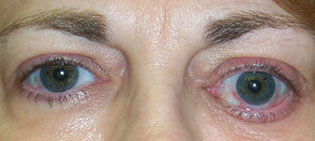Thyroid Related Eye Disease
Treatments - Photographs
- Graves' ophthalmopathy generally causes the eyelids to open more widely.
- The front surface of the eyeball becomes exposed beyond the eyelids and causes discomfort and excessive tearing; exposure keratopathy.
- Surgically repositioning the eyelids can reduce the irritation.
Pre - Operative Photograph
Post - Operative - 2 weeks after lowering upper eyelids
Upper Eyelid Retraction II
Pre-Operative Photograph showing RIGHT upper eyelid retrac tion
Post-Operative Photograph showing normal upper eyelid position
Pre-Operative Photograph showing upper eyelid retraction
Post-Operative Photograph showing normal upper eyelid position
Lower Eyelid Retraction
Pre-Operative Photograph showing
LEFT LOWER eyelid retraction
Post-Operative (3 Weeks) Photograph
showing LEFT lower eyelid position
Graves' disease is an autoimmune disease. It most commonly affects the thyroid, causing it to grow to twice its size or more (goiter), be overactive, with related hyperthyroid symptoms such as increased heartbeat, muscle weakness, disturbed sleep, and irritability. It can also affect the eyes, causing bulging eyes (exophthalmos). It affects other systems of the body, including the skin and reproductive organs. It affects up to 2% of the female population, often appears after childbirth, and has a female:male incidence of 5:1 to 10:1. It has a strong hereditary component; when one identical twin has Graves' disease, the other twin will have it 25% of the time. Smoking and exposure to second-hand smoke is associated with the eye manifestations but not the thyroid manifestations. Diagnosis is usually made on the basis of symptoms, although thyroid hormone tests could be useful, particularly to monitor treatment.








